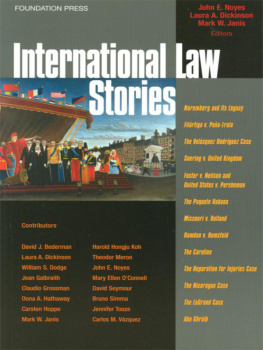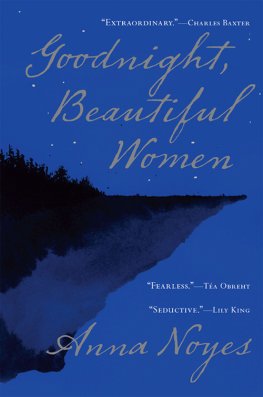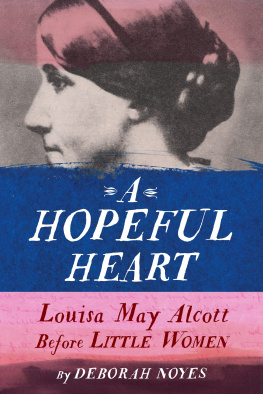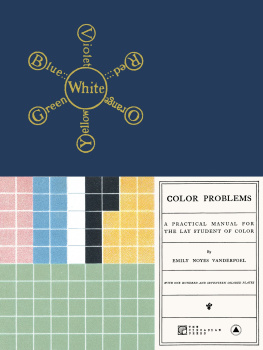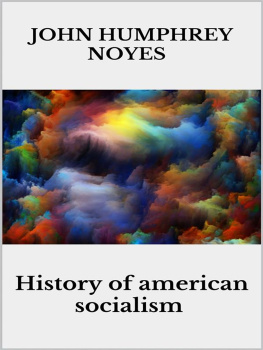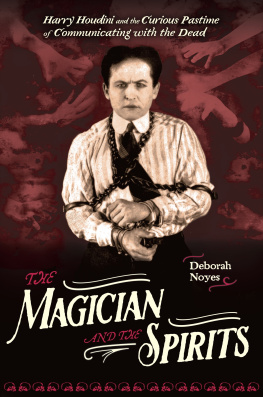John Noyes - International Law Stories
Here you can read online John Noyes - International Law Stories full text of the book (entire story) in english for free. Download pdf and epub, get meaning, cover and reviews about this ebook. year: 2016, publisher: West Academic, genre: Romance novel. Description of the work, (preface) as well as reviews are available. Best literature library LitArk.com created for fans of good reading and offers a wide selection of genres:
Romance novel
Science fiction
Adventure
Detective
Science
History
Home and family
Prose
Art
Politics
Computer
Non-fiction
Religion
Business
Children
Humor
Choose a favorite category and find really read worthwhile books. Enjoy immersion in the world of imagination, feel the emotions of the characters or learn something new for yourself, make an fascinating discovery.
- Book:International Law Stories
- Author:
- Publisher:West Academic
- Genre:
- Year:2016
- Rating:4 / 5
- Favourites:Add to favourites
- Your mark:
- 80
- 1
- 2
- 3
- 4
- 5
International Law Stories: summary, description and annotation
We offer to read an annotation, description, summary or preface (depends on what the author of the book "International Law Stories" wrote himself). If you haven't found the necessary information about the book — write in the comments, we will try to find it.
International Law Stories — read online for free the complete book (whole text) full work
Below is the text of the book, divided by pages. System saving the place of the last page read, allows you to conveniently read the book "International Law Stories" online for free, without having to search again every time where you left off. Put a bookmark, and you can go to the page where you finished reading at any time.
Font size:
Interval:
Bookmark:

By
JOHN E. NOYES
Professor of Law
California Western School of Law
LAURA A. DICKINSON
Professor of Law
University of Connecticut School of Law
MARK W. JANIS
William F. Starr Professor of Law
University of Connecticut School of Law

Cover Design: Keith Stout
Photo Credit: The Representatives of Foreign Powers Coming to Salute the Republic as a Sign of Peace, 1907 (oil on canvas) by Rousseau, Henri J.F. (Le Douanier) (18441910)
Musee Picasso, Paris, France/Lauros/Giraudon/The Bridgeman Art Library
Nationality/copyright status: French/out of copyright
This publication was created to provide you with accurate and authoritative information concerning the subject matter covered; however, this publication was not necessarily prepared by persons licensed to practice law in a particular jurisdiction. The publisher is not engaged in rendering legal or other professional advice and this publication is not a substitute for the advice of an attorney. If you require legal or other expert advice, you should seek the services of a competent attorney or other professional.
Nothing contained herein is intended or written to be used for the purposes of 1) avoiding penalties imposed under the federal Internal Revenue Code, or 2) promoting, marketing or recommending to another party any transaction or matter addressed herein.
2007 By FOUNDATION PRESS
395 Hudson Street
New York, NY 10014
Phone Toll Free 18778881330
Fax (212) 3676799
foundationpress.com
Printed in the United States of America
ISBN 9781599410869

International Law Stories explores the personal, social, political, and historical foundations of thirteen classic international law cases. The authors of our essayslaw school deans and professors, international court judges, and government lawyersbring these stories to life, telling tales helpful, we hope, for those well-acquainted with the cases, as well as for those new to the field. One short book cannot address all the important cases in the vast arena of international law, but these essays provide a rich and lucid understanding of modern international law.
International Law Stories has three parts. Part I, Nuremberg and Its Progeny, begins with the story about the judgment of the International Military Tribunal at Nuremberg, by Judge Theodor Meron of the International Tribunal for the former Yugoslavia and Jean Galbraith. Following are three chapters on cases from other courts, each building on Nuremberg : Filrtiga from a U.S. federal court, by Dean Harold Koh of Yale Law School; Velsquez Rodrguez from the InterAmerican Court of Human Rights, by Dean Claudio Grossman of American Universitys Washington College of Law; and Soering from the European Court of Human Rights, by David Seymour, the Legal Adviser to the U.K. Home Office, and Jennifer Tooze, also of the Home Office. These four cases, all of which concern the human rights or humanitarian law obligations of states, feature the individual as a central actor in international law.
Part II, International Law: The Domestic Impact, also has four chapters, each of them looking at how the U.S. legal system has treated the complex interplay among international law, constitutional law, and domestic politics and culture. Professor Carlos Vzquez of the Georgetown University Law Center explores Foster & Elam and Percheman ; Professor William Dodge of the University of Californias Hastings College of Law considers The Paquete Habana ; Professor Mark Janis of the University of Connecticut School of Law writes about Missouri v. Holland ; and Professor Oona Hathaway of Yale Law School presents Hamdan .
Finally, Part III, International Law: Interstate Conflicts, contains five chapters showing how international law and process have addressed controversies over the use of force, the development of international institutions, the treatment accorded citizens of one country who are accused of crimes in another, and the treatment of detainees in the war on terror. The chapters in Part III include: Caroline , by Professor John Noyes of California Western School of Law; Reparation for Injuries , by Emory University Law Professor David Bederman; Nicaragua , by Professor Mary Ellen OConnell of Notre Dame Law School; LaGrand , by Judge Bruno Simma of the International Court of Justice and Carsten Hoppe; and Abu Ghraib, by Professor Laura Dickinson of the University of Connecticut School of Law.
This Introduction continues with three short essays by the editors of International Law Stories , providing perspective on the contents of this volume. The first, by Mark Janis, discusses what makes an international law case a classic. John Noyes, in the second introductory essay, explores the wide variety of fora that interpret and apply international law. Third, Laura Dickinson reflects on the efficacy of international law in our cases.
What makes an international law case a classic? How have we decided what to include as classic international law cases for International Law Stories ? We can think of at least three tests to determine classic status. The first is reliance: Is the case one on which international lawyers rely? Do international lawyers make steady reference to the case in subsequent practice? The second test is transformation: Has the case changed international law? Have international lawyers come to think about and to do their discipline differently because of the case? And third is expectation: Is the case one that international lawyers are expected to know? Could one be counted a real international lawyer if one was not familiar with the case?
Since all tests of classic status involve opinion, we acknowledge that it will be much harder to agree upon classic cases in international law than upon cases in a subject matter drawn from a single legal system, like that of the United States. Plainly, there will always be a greater degree of intellectual, social, and professional coherence among lawyers from a single country about a domestic legal field like U.S. constitutional law, property law, or tort law, than there will be among lawyers from almost two hundred different countries about international law, a fundamentally shared legal field. So, to be honest, we must admit that deciding what cases to include in International Law Stories is colored by the fact that we three editors are all American, all educated at U.S. law schools (though one was first educated at an English law school), all members of a bar of a state of the United States, and all professors at U.S. law schools. Moreover, we perceive our principal audience to be students, though not necessarily American, taking courses in U.S. law schools or undergraduate and graduate schools, or U.S. lawyers, judges, and academics. Hence, our choice of classic international law cases has, and is meant to have, a distinctly American flavor. As international lawyers, of course, we are by trade and emotion keenly sympathetic with foreign audiences; we hope that our choice of cases will also reach out to foreign students, lawyers, judges, and academics.
Font size:
Interval:
Bookmark:
Similar books «International Law Stories»
Look at similar books to International Law Stories. We have selected literature similar in name and meaning in the hope of providing readers with more options to find new, interesting, not yet read works.
Discussion, reviews of the book International Law Stories and just readers' own opinions. Leave your comments, write what you think about the work, its meaning or the main characters. Specify what exactly you liked and what you didn't like, and why you think so.

